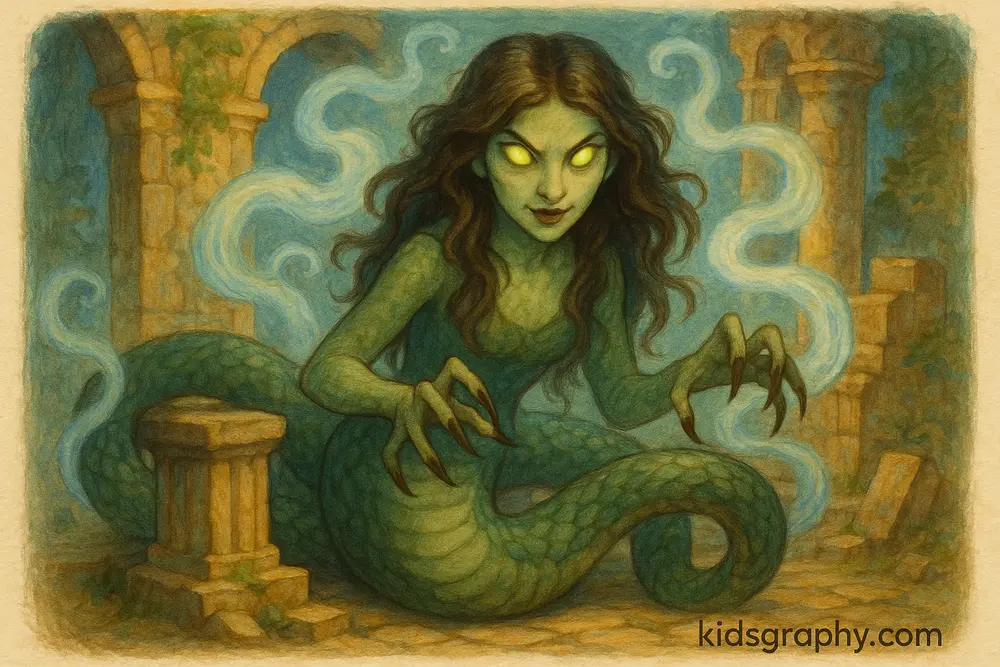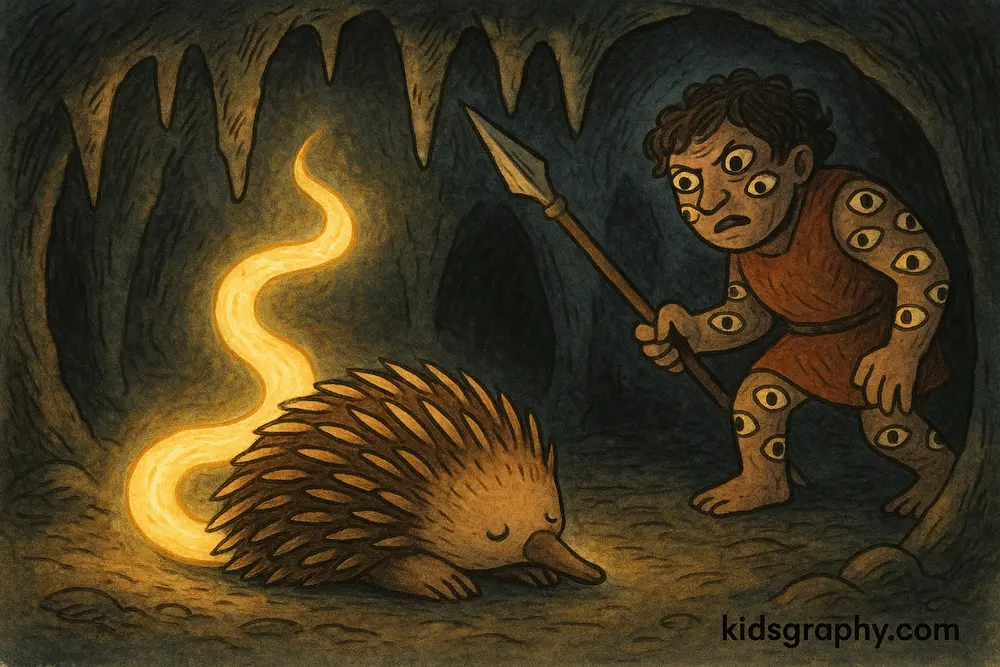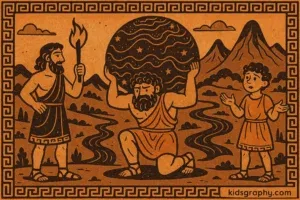In Greek mythology, Echidna is a fearsome creature known as the “Mother of Monsters.” She is described as half-woman, half-snake, with the upper body of a beautiful woman and the lower body of a giant serpent. Her name alone sent chills down the spines of heroes and gods alike.
Echidna lived in dark, remote caves, hiding away from the world while giving birth to some of the most terrifying creatures in Greek myths.
Read More: Perseus in Greek Mythology: Hero, Slayer of Medusa
Echidna and Typhon: The Monster Power Couple
Echidna’s mate was Typhon, one of the most powerful and dangerous monsters in mythology. Together, they formed a duo feared by the gods. Typhon had one hundred dragon heads, and Echidna matched his terrifying strength with her cunning and cruelty.
Their union gave rise to many legendary beasts that challenged gods and heroes alike.
Echidna’s Monstrous Children
Echidna and Typhon were the parents of many terrifying creatures, including:
- Cerberus – the three-headed dog guarding the gates of the Underworld
- Hydra – the multi-headed serpent defeated by Hercules
- Chimera – a fire-breathing beast with a lion’s head, goat’s body, and snake tail
- Sphinx – the riddle-asking creature with a lion’s body and a woman’s face
- Nemean Lion – a lion with impenetrable skin, also defeated by Hercules
Echidna’s children became famous for their battles with Greek heroes. Most were eventually slain, but their legends lived on.
Read More: Ares in Greek Mythology: God of War and Fury
Where Did Echidna Live?
Echidna was said to live in a cave deep beneath the Earth, in places far from human reach. Some ancient texts place her home in Cilicia or under the earth near Tartarus, the deep abyss used as a dungeon of torment.
Her hiding spot allowed her to protect her monstrous children and avoid confrontation—until the gods finally acted.
What Happened to Echidna?
The Greek gods saw Echidna and Typhon as threats. Zeus, king of the gods, fought and defeated Typhon in a fierce battle. Zeus allowed Echidna to live for a while so her offspring could challenge future heroes. Later, he ordered Argus Panoptes—a giant with a hundred eyes—to slay her in her sleep.
Even in death, her children continued to spread fear and chaos, living up to her monstrous legacy.
Read More: Hyperion in Greek Mythology: Titan of Heavenly Light
Echidna’s Role in Greek Mythology
Echidna’s role in Greek mythology is that of a primordial monster, deeply tied to chaos, danger, and fear. Yet, she also plays a vital part in the heroic journeys of many legendary figures. Without her monstrous offspring, many Greek heroes wouldn’t have had their famous battles or quests.
She’s a symbol of the dark, untamed side of nature—unpredictable and deadly.
Read More: Cassandra in Greek Mythology: The Cursed Prophetess
Symbolism of Echidna: Chaos, Nature, and the Unknown
Echidna isn’t just a monster—she represents something much deeper. Many myths use monsters like Echidna to symbolize nature’s darker side—the parts that are wild and uncontrollable. With her half-beautiful, half-terrifying form, Echidna reminds us that appearances can be deceiving.
- Her human half represents beauty, seduction, and disguise.
- Her serpent half symbolizes danger, cunning, and primal power.
In this way, Echidna stands as a bridge between human civilization and wild, unpredictable forces. Heroes who face her offspring are not just fighting beasts—they’re battling their deepest fears and limitations.
Read More: Nike in Greek Mythology: Goddess of Victory
Echidna in Ancient Art and Literature
Unlike gods like Athena or Apollo, Echidna wasn’t commonly shown in statues or paintings. She was more of a legendary figure, described in epic poems and ancient writings. Hesiod, in Theogony, is one of the earliest authors to mention her, describing her as a ‘she-dragon’ and the mother of many beasts.
However, in some ancient pottery and manuscripts, artists did attempt to depict her:
- Often shown emerging from caves or surrounded by monstrous children
- Sometimes with glowing eyes, snake scales, and flowing dark hair
- Her image appears in later Roman and Renaissance illustrations, often labeled with horror and mystery
These depictions made her a symbol of the wild and uncontrollable aspects of life—a force that even gods had to respect.
Read More: Talos in Greek Mythology: The Bronze Giant of Crete
Echidna’s Legacy in Pop Culture
Though she’s not as famous as Medusa or the Hydra, Echidna appears in modern books, games, and TV shows, often as a villain or dark mother figure.
You’ll find her in:
- 📚 Rick Riordan’s Percy Jackson series, where Echidna challenges young demigods
- 🎮 Myth-based video games, sometimes as a boss or powerful spirit
- 📺 Fantasy shows or anime as inspiration for hybrid creatures or monstrous mothers
- 🧩 Role-playing games (like Dungeons & Dragons), where creatures called “Echidnas” have traits from the myth
Scientists named the spiny Australian mammal ‘echidna’ because of its strange and unique nature, much like the mythical creature.
More Stories: Echidna in Greek Mythology
FAQ: Echidna in Greek Mythology
Echidna is a half-woman, half-serpent creature known as the Mother of Monsters. She gave birth to many of the deadliest beasts in mythology.
Echidna and her mate Typhon produced monsters like Cerberus, Hydra, Chimera, Sphinx, and the Nemean Lion.
She was a monstrous being, not a goddess. Echidna had divine ancestry but was feared as a chaos-bringer in mythology.
According to myths, the giant Argus Panoptes killed Echidna while she slept, under Zeus’s orders.
Echidna represents the origin of many challenges faced by heroes, making her a key figure in the mythological world of monsters.











